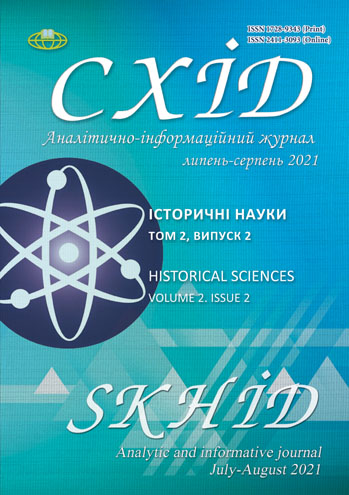WHY DID THE UKRAINIANS DISAPPEAR ON KUBAN?
FAMINE (HOLODOMOR)-GENOCIDE ON THE NORTHERN CAUCASUS (KUBAN) DURING 1932-1933-s
DOI:
https://doi.org/10.21847/1728-9343.2021.2(2).239369Keywords:
the Northern Caucasus, Kuban, famine, genocide, village, the Cossacks, the Soviet governmentAbstract
An issue, regarding famine (Holodomor) – genocide organization that was performed by the Soviet system on Kuban where the Ukrainians constituted majority, is considered in the article. The particular schemes of the deliberate policy oriented on physical annihilation of the Ukrainian population on Kuban, destruction of the national, ethnical and group (Cossacks’) identity, cessation of national-cultural development, forced russification, all abovementioned are the characteristics of genocide, the main features of which were determined by a particular UN resolution in 1948. The authors provide the particular data that reveal a deliberate policy of the USSR aimed at annihilation of the Ukrainians on the Northern Caucasus (Kuban). Provided factual data is based on the wide range of archival sources, testimonies of witnesses, publications of the scientific studies. The authors’ analysis permits to conclude that a deliberate policy was provided regarding the Ukrainians on Kuban that were an inherent part of the general Ukrainian national space during 1932-1933-s, namely the policy included mass physical annihilation via artificial famine, repressions, deportations as well as via different means of the Ukrainians’ denationalization. The processes were on the territory of the USRR as well as in the places of high concentration of the Ukrainians beyond its borders, particularly on the Northern Caucasus. The specific implications of the work are to highlight the methods that the Soviet government used against the Ukrainians on Kuban at the abovementioned period, the authors consider the measures as genocide based on the UN resolution of 1948, moreover, the analysis of the statistical data is provided to prove the scale of physical loss of the Ukrainians on Kuban. Considering that the scientific issue of the his-tory of the Ukrainians on the Northern Caucasus (Kuban) at the period of famine (Holodomor) du¬ring 1932-1933-s only begins to be reflected, the results of the article can be a base for the further studies and more deep consideration of one of the greatest disasters in the 20th century – Famine (Holodomor)-genocide of the Ukrainian nation.
Downloads
References
Bilyi, D. (2020). Ukrainization in Kuban in the 1920s and 1930s: legitimation and delegitimation through the prism of historical memory. Skhid, 4(168), 5-9. https://doi.org/10.21847/1728-9343.2020.4(168).210913
Churkin, V. (1991). Neizvestnaya voyna. Don, 7 (In Russian).
Conquest, R. (2007). Zhnyva skorboty. Radianska kolektyvizatsiia i holodomor. Lutsk. (In Ukrainian).
Eidelman, N. (1990). Takiye lyudi. Ogonek, 28: 17-19. https://imwerden.de/pdf/eidelman_takie_lyudi_1990__ocr.pdf (In Russian).
Itogi Vsesoyuznoy perepisi naseleniya 1959 goda. (1962). Moscow: Gosstatizdat. (In Russian).
Kulchytsky, S. (2005). Holodomor 1932 – 1933 rr. v Ukrayini yak henotsyd. Problemy istoriyi Ukrayiny: fakty, sudzhennya, poshuky. 14: 225-300. http://resource.history.org.ua/-publ/pro_2005_14_225 (In Ukrainian)
Kulchytsky, S. (2007). Holodomor 1932-1933 rr. yak henotsyd: trudnoshchi usvidomlennia. Kyiv: Nash chas. (in Ukrainian).
Kulchytsky, S. (2008). Holod 1932-1933 rr. yak henotsyd: movoyu dokumentiv, ochyma svidkiv. Kyiv: Nash chas. (in Ukrainian).
Kulchytsky, S. (2013). Ukrayinskyy Holodomor v konteksti polityky Kremlya pochatku 1930-kh rr. Kyiv: Instytut istoriyi NAN Ukrayiny. (in Ukrainian).
Levchenko, V. (1969). Chernyye doski. Kuban, 7: 55 (In Russian).
Lisovyy, P. (927). Kuban. Kharkivski visti. 03 May, 18 June. (In Ukrainian).
Makedonov, L.V. (1907). Naseleniye Kubanskoy obpasti po dannym vtorykh ekzemplyarov listov perepisi Í897. Yekaterinodar. (In Russian).
Pyrih, R.Ya. (compil.) (2007). Holodomor 1932-1933 rokiv v Ukrayini: dokumenty i materialy. Kyiv: Vyd. dim «Kyivo-Mohylyanska akademiya» (In Ukrainian).
Rakachev, V. N. (2006). Ukraintsy na Kubani: osobennosti demograficheskoy istorii. Kuban-Ukraina. Voprosy istoriko-kul'turnogo vzaimodeystviya. Krasnodar: Izd-vo OK-PRESS: 45-57 (In Russian).
Rudnytskyy, S. (1923). Osnovy zemleznavstva Ukrayiny (Vol 1). Praha. (In Ukrainian).
Serbyn, R. (2009). Rafael Lemkin. Radianskyi henotsyd v Ukraini (stattia 28 movamy). Kyiv, 208 рр. https://clck.ru/WuZuZ (In Ukrainian).
Serhiychuk, V. (2015). Holodomor 1932-1933 rokiv yak henotsyd ukrayinstva. Vyshhorod. (in Ukrainian)
The Foreign Office and the Famine (1988). New York, 86 p.
Zastavnyy, F. (1992). Skhidna ukrayinska diaspora. Lviv. (In Ukrainian).
Downloads
Published
How to Cite
Issue
Section
License
Copyright (c) 2021 DMYTRO BILYI, IVAN PETRENKO

This work is licensed under a Creative Commons Attribution-NonCommercial-NoDerivatives 4.0 International License.
1. Authors bear responsibility for the accuracy of facts, quotations, numbers and names used.
2. Manuscripts are not sent back.
3. The publisher does not always agree with the authors' opinion.
4. The authors reserve the right to authorship of the work and pass the first publication right of this work to the journal under the terms of a Creative Commons Attribution-NonCommercial-NoDerivatives 4.0 International License. This license allows others to distribute (copy) the published work for non-commercial purposes, provided there is mandatory attribution to its authors and a link to the first publication in our journal.
5. The authors have the right to conclude separate supplement agreements that relate to non-exclusive work distribution in the form in which it has been published by the journal (for example, to upload the work to the online storage of the journal or publish it as part of a monograph), provided that the reference to the first publication of the work in this journal is included.

